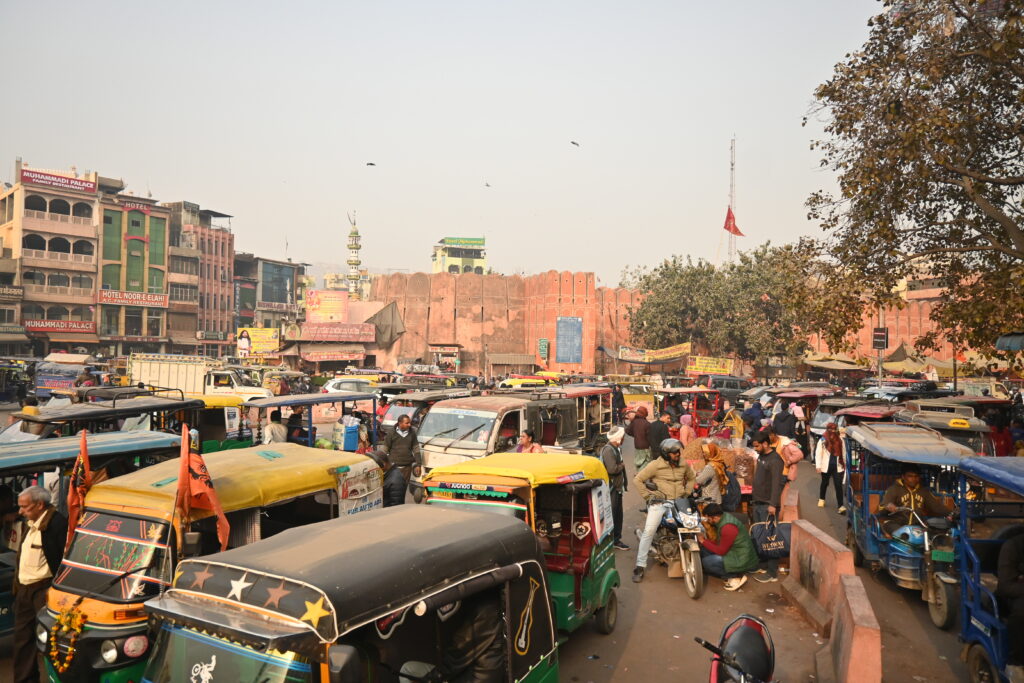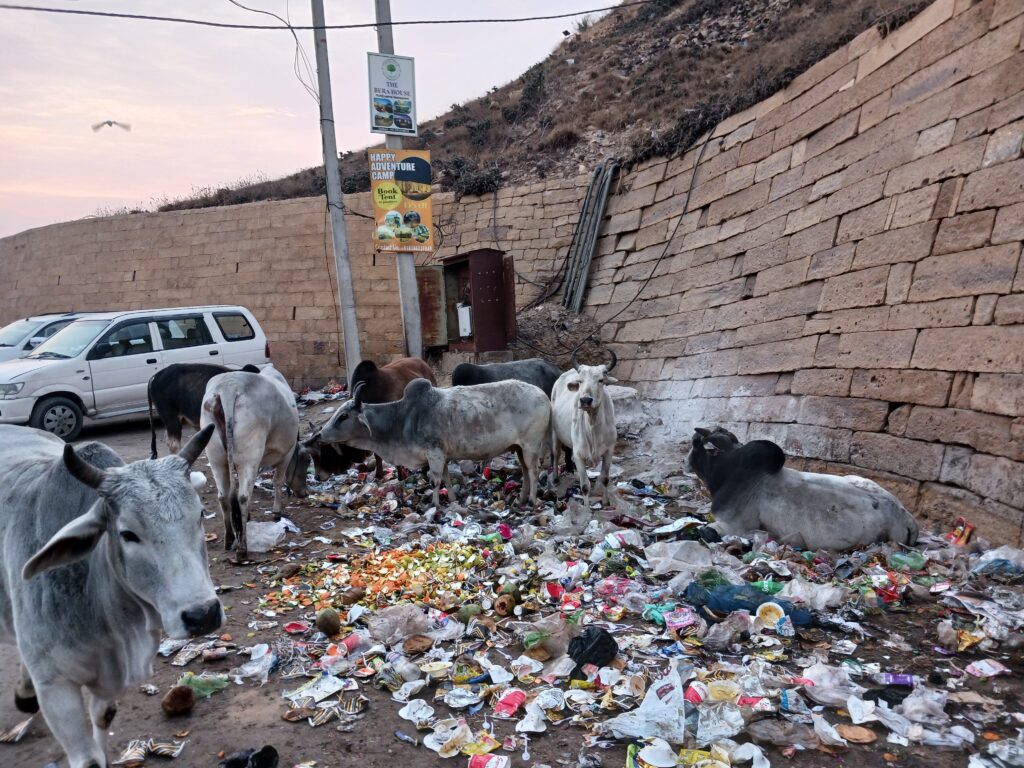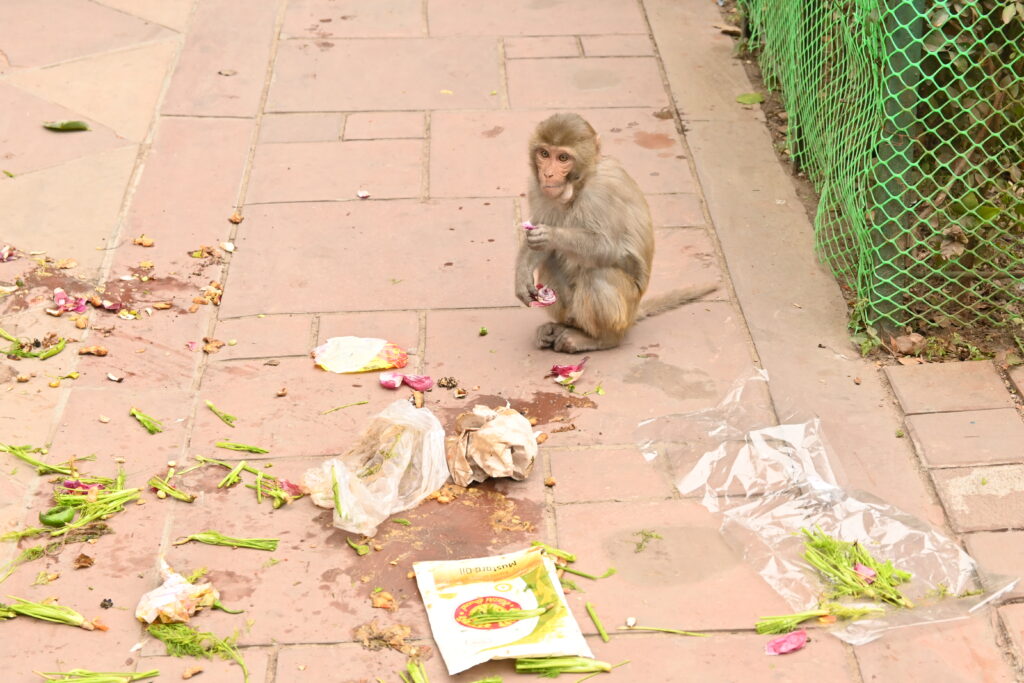THE HAIRY GIRAFFE… IN RAJASTHAN
After three weeks in Rajasthan, it’s time to reflect. How did we experience this journey? What were our joys, disappointments, questions, doubts, and discoveries? This is not merely an assessment of a country but rather of a trip—how we perceived it individually and subjectively.
 We are François and Benjamin, Canadian and French giraffe hairstylists and travel enthusiasts. On this blog, discover our travels, tips, moods, and everything you need to become a giraffe hairstylist and embark on travelling the world. An honest blog with photos guaranteed 100% unfiltered and untouched. |
François’ Travel Reflections
We traveled to India as part of our round-the-world trip. I want to clarify that coming to India was Benjamin’s idea. Personally, I wasn’t very keen on going. Although the idea of seeing the Taj Mahal was appealing, I feared the journey would be challenging. India is not known for being an easily accessible country, particularly due to its poor hygiene.
I eventually agreed to go, thinking it was an opportunity. We were passing through (I would never have made a trip specifically to see India), and over time, I’ve become a seasoned traveler. It should be manageable…
“Toto, I have a feeling we’re not in Kansas anymore.”
Dorothy had a shock landing in the land of Oz. I believe she would have dropped dead from cardiac arrest if the tornado had taken her to Delhi. While Delhi’s airport and its express metro connecting to the city center are modern and clean, the exit from the train station was impactful. Here, no good witches or Munchkins singing in joy and cheerfulness. We find ourselves in complete chaos: cars and tuk-tuks honking more than they’re moving, cows on the roads, people everywhere, and waste as far as the eye can see. All enveloped in a constant haze of pollution. There’s no doubt: we have left the United Arab Emirates.

Upon arrival, my reaction was the same as Dorothy’s: I want to go home. Less than 5 minutes in all this mess, and all my deepest concerns and preconceived ideas about this country are confirmed.
The road from our hotel to the grocery store has nothing to do with the nice yellow brick road that Dorothy took. We have crowded roads with vehicles that don’t follow any traffic rules (I think it must be non-existent here). It moves in all directions. Drivers respect no priorities. French, your right-of-way, good luck finding it. Quebecois, your pedestrian priority, better not think about it; you might end up in the cemetery in seconds.
Here, vehicules don’t give an inch. All drivers declare themselves the priority. A pedestrian crosses the street; too bad, I rush, they’ll have to move. A car wants to merge into traffic, pff, not a chance, I go. Indians drive by honking; they believe that simply honking gives them the right of way. And since they all believe they have the right of way, it quickly becomes a big mess.

Dorothy had a relatively easy path between the Munchkin village and the Emerald City. She was lucky. In addition to having to zigzag between cars, we also had to learn to avoid the ubiquitous waste in the streets. There’s something for everyone: various plastics, cardboard, glass, fabrics, food leftovers, animal and even human excrements (yes, even human…), dead animals… All under a ton of dust.
Walking the streets of Indian cities (you will quickly notice that almost all cities are as dirty as each other) is like walking in an open-air dump. Greta Thunberg would have something to do here! When you read travel bloggers saying that India is “a bit” dirty, it’s a blatant lie. Either they have never really set foot there and only imagine a completely utopian India, or they went, but they wore rose-colored glasses throughout their trip.
Let’s be honest: the India we saw is not “a bit” dirty. It’s downright filthy. Indians do nothing to change this. Firstly, the bins are almost nonexistent in the cities we visited. Maybe that’s why people throw everything on the ground (to the great delight of rats, dogs, cows, monkeys, and others). The packaging of the samosa they just bought: on the ground. The empty chip bag: on the ground. The rest of the dal: on the ground. The metro ticket they just used to exit: on the ground. And this applies to all social classes. We even saw this behavior on a train. A seemingly affluent man casually threw his medication and cookie wrappers on the train floor…



The number of men we saw urinating on the street is quite significant and would make any festival organizer blush. A lamppost, a mound of waste, the wall of a house or a UNESCO-listed fort… anything serves as an improvised toilet. We must not forget to mention that a majority of Indians burp (often in your ear) and spit. Chewing tobacco, betel, saliva, any liquids, the reasons are multiple. We are, once again, far from Oz.

To drive the point home and understand that we didn’t land in Oz (or Kansas, for that matter), we didn’t have the same encounters as Dorothy. Unlike her, who had the opportunity to meet friendly companions during her journey, our encounters with Indians were primarily… commercial, with our money at the heart of them. Almost every time an Indian approached us, it was to extract money from us in one way or another. They often went straight to the point, leaving their shops to invite us in or stopping their tuk-tuks at our height to make us climb in. We saw several of them rushing directly towards us Western tourists, completely ignoring other Indian tourists around us. Some merchants even left their shops and crossed the street to meet us.
Others were more subtle and tried another method. In Delhi in particular, several Indians approached us the same way. They came to our height and all said the same thing: “Hello sir! What’s your name? Where are you from?” Just after answering their questions, the subtlety falls. They try to sell us their guide services or want to take us to their shop (or a friend’s shop) that sells “cheap” stuff.
We even had a tuk-tuk driver who, seeing us walking, approached us to say that the road we were walking on was closed, and that only he could take us to our destination… without us telling him where we were going. If at first it’s anecdotal or even funny, it quickly becomes exasperating when it’s no longer possible to take two steps without being assaulted.
Another quite striking thing is that Dorothy and her friends were only four strolling on the yellow brick road in an apparently empty country. Of course, it’s easy to frolic there while singing. Here, with nearly 1.5 billion inhabitants, it’s more complicated. There are people everywhere. Forget your need for peace and solitude. Don’t expect to frolic like Dorothy. If you don’t get hit by a tuk-tuk for the aforementioned reasons, it’s simply a pedestrian who will walk into you.
I don’t know if it’s because they are so numerous, but Indians seem to be very individualistic. They systematically cut lines. They push and shove to get into a train. Each listens to their music or TV show in public transport (without headphones, of course). They have no qualms about pushing you when they want to take a photo, and once their photo is taken, they stay in place, forcing you to have them in yours.
In all the hotels we stayed at, Indians made our stay difficult. When it’s not tourists partying until the early hours or playing loud music to shower at 10 p.m. in a bathroom with walls as thin as cardboard, it’s the guesthouse owners doing the dishes at 11 p.m. in their kitchen adjacent to your room or letting their children run and shout everywhere when we want to sleep.


The Indians also have no problem entering your personal space to look at your phone or camera screens. They take the opportunity to offer you a tuk-tuk if they see you on Google Maps or to comment on the photo you just took and which appears on your screen. They also have no problem photographing Western tourists. While some do it politely, asking for your permission, others simply take your picture when you pass by them or frame you in their selfie in a not very subtle way. All of this makes us feel like they care about nothing but themselves and their comfort.
We often say that Westerners, and Americans in particular, are very individualistic. I am North American. I have been to many countries. Never have I felt such an I-don’t-care attitude towards others. Maybe it’s not individualism, but a lack of civility? In any case, there are clearly social codes that I have not understood. It’s perhaps this lack of understanding that made my trip to India so unpleasant.
Is India worth visiting?
You will have understood, I did not fall under the charm of India or Rajasthan. The omnipresent noise, visual and olfactory pollution, the blatant lack of hygiene, constant noise, lack of privacy, and the lack of civility of Indians are huge arguments against this country. If we add that tourist sites (excluding the Taj Mahal) are generally poorly maintained and sometimes decrepit, it starts to add up.

I have nothing against living for some time in conditions with approximate comfort if it’s to see exceptional sites. Unfortunately, in India, nothing seemed to be at the level to counterbalance the unpleasant travel experience. Certainly, there are exceptions. The Taj Mahal is simply beautiful. It’s undoubtedly the Indian Emerald City. You just have to manage to see it because with Agra’s pollution, it’s not guaranteed. The city of Udaipur is also worth a visit. Colorful, clean, more intimate, it is different, and it feels good, almost like we changed countries. And… that’s it!
Maybe I would have had a different opinion if I had made the trip on an organized tour with my rose-colored glasses and stayed in high-end hotels? I will never know. I prefer to watch The Wizard of Oz again; it’s more enjoyable. If Dorothy has happily returned to Oz, I will never go back to India. It’s not worth it.
Time to go! I happily put on my ruby slippers, click my heels three times, and I’m going to rest elsewhere.
Check out Benjamin’s Travel Reflections:
Find all our other articles on Rajasthan :




